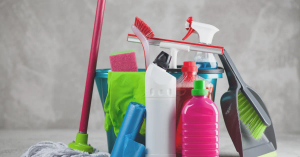As parents, we always want the best for our children, especially when it comes to their health and safety. The cosmetic industry offers a plethora of products designed for babies, claiming to be gentle, natural, and beneficial. However, not all baby cosmetics live up to these promises. Some contain harmful ingredients that can cause more harm than good. This article will explore cosmetic products commonly marketed for babies that parents should approach with caution, backed by research and expert recommendations.
Baby Powder
Why It's Advertised:
Baby powder is often marketed as a product to keep babies dry and prevent diaper rash. It is touted as a must-have for maintaining a baby’s soft skin.
The Reality:
Many baby powders contain talc, which has been linked to respiratory issues when inhaled. More concerningly, some talc has been found to be contaminated with asbestos, a known carcinogen. A study by the American Academy of Pediatrics (AAP) advises against the use of talcum powder on infants due to the risk of inhalation, which can cause lung damage or respiratory diseases .
Baby Lotions and Creams
Why They're Advertised:
Baby lotions and creams are promoted to keep a baby's skin soft, moisturized, and free from irritation.
The Reality:
Many of these products contain fragrances, parabens, and phthalates. Fragrances can cause allergic reactions and skin irritation. Parabens are preservatives that have been linked to hormonal disruptions and an increased risk of cancer. Phthalates, often used to make fragrances last longer, have been associated with developmental issues and endocrine disruption. A report by the Environmental Working Group (EWG) highlights the potential risks of these chemicals and recommends choosing fragrance-free and paraben-free products .
Baby Wipes
Why They're Advertised:
Baby wipes are marketed as convenient and essential for keeping a baby's skin clean and fresh, especially during diaper changes.
The Reality:
Many baby wipes contain alcohol, fragrances, and preservatives like methylisothiazolinone, which can cause skin irritation, allergic reactions, and even chemical burns. A study published in the Journal of Pediatric Dermatology has shown that these ingredients can lead to contact dermatitis in infants . Opting for wipes labeled as hypoallergenic and free from harsh chemicals is a safer choice.
Baby Shampoo and Body Wash
Why They're Advertised:
These products are sold as gentle cleansers designed to maintain a baby's delicate skin and hair.
The Reality:
Sulfates, such as sodium lauryl sulfate (SLS) and sodium laureth sulfate (SLES), are common in many baby shampoos and washes. These chemicals can strip natural oils from the skin and cause dryness and irritation. Additionally, some shampoos contain formaldehyde-releasing preservatives, which are known carcinogens. According to the Campaign for Safe Cosmetics, avoiding products with sulfates and formaldehyde-releasing preservatives is crucial for a baby's health .
Sunscreen for Babies
Why It's Advertised:
Sunscreen is essential for protecting a baby’s sensitive skin from harmful UV rays.
The Reality:
While sunscreen is important, many products contain oxybenzone, a chemical that can be absorbed through the skin and has been linked to hormonal disruptions. The American Academy of Dermatology (AAD) recommends using sunscreens with physical blockers like zinc oxide or titanium dioxide, which are safer for infants' skin .
Common Harmful Ingredients in Baby Cosmetics
Parabens
What are Parabens? Parabens are a group of synthetic compounds commonly used as preservatives in cosmetics and personal care products. They prevent the growth of harmful bacteria and mold.
Why They Are Harmful Parabens can mimic estrogen, a hormone in the body, and disrupt the endocrine system. Studies have linked parabens to developmental and reproductive toxicity, as well as allergic reactions.
Research Findings A study published in the Journal of Applied Toxicology found that parabens can penetrate the skin and accumulate in the body, potentially leading to hormone disruption and other health issues .
Phthalates
What are Phthalates? Phthalates are used to make plastics more flexible and are found in many personal care products as solvents and fixatives.
Why They Are Harmful Phthalates are endocrine disruptors and have been associated with a variety of health problems, including developmental and reproductive toxicity, as well as asthma and allergies.
Research Findings The Centers for Disease Control and Prevention (CDC) found that exposure to certain phthalates has been associated with altered reproductive development in male infants and increased risks of asthma and allergies .
Formaldehyde-releasing preservatives
What are Formaldehyde-releasing Preservatives?
These preservatives slowly release small amounts of formaldehyde over time to prevent microbial growth.
Why They Are Harmful Formaldehyde is a known carcinogen and can cause skin irritation, allergic reactions, and respiratory issues.
Research Findings A study in the American Journal of Industrial Medicine highlighted that formaldehyde exposure, even in small amounts, can lead to significant health concerns, particularly for infants with developing immune systems .
Fragrance
What is Fragrance? Fragrance in cosmetics can be made up of a complex mixture of chemicals, including allergens and irritants.
Why They Are Harmful Fragrances can cause allergic reactions, skin irritation, and may include hormone-disrupting chemicals.
Research Findings The Environmental Working Group (EWG) has reported that many fragrance ingredients can cause dermatitis, respiratory distress, and potential effects on the reproductive system .
Incidents and Studies Highlighting the Risks
Case Studies
- Johnson & Johnson Baby Powder In 2018, Johnson & Johnson faced thousands of lawsuits claiming that their baby powder, which contained talc, was contaminated with asbestos and caused cancer. Although the company denied the allegations, they ultimately decided to discontinue the product in North America .
- Aveeno Baby Calming Comfort Bath Parents reported cases of skin rashes and allergic reactions in babies after using Aveeno Baby Calming Comfort Bath. Despite being marketed as gentle and safe for babies, the product contained fragrance, which can be a potent allergen .
Scientific Research
- The Risk of Parabens and Phthalates A comprehensive study published in the Journal of Exposure Science & Environmental Epidemiology found that infants and toddlers are more exposed to harmful chemicals like parabens and phthalates through personal care products compared to adults. The study highlighted the need for stricter regulations and safer alternatives .
- Formaldehyde Exposure Research conducted by the National Toxicology Program (NTP) revealed that formaldehyde exposure is particularly harmful to infants and young children due to their developing respiratory systems and immune responses .
Safer Alternatives
Natural and Organic Options
- Shea Butter Natural shea butter is an excellent moisturizer for baby skin, free from harmful chemicals and preservatives.
- Coconut Oil Organic coconut oil can be used as a gentle moisturizer and is known for its antibacterial properties.
- Aloe Vera Pure aloe vera gel can soothe irritated skin and is safe for use on babies.
DIY Baby Skincare Recipes
- Homemade Baby Lotion
- Oatmeal Bath
Conclusion
While the cosmetics industry markets many products as safe and beneficial for babies, it is crucial to scrutinize these claims and be aware of potentially harmful ingredients. Parabens, phthalates, formaldehyde-releasing preservatives, and fragrances are common culprits that can pose significant health risks. By opting for natural and organic alternatives, or even making your own baby skincare products, you can ensure that your baby's skin remains healthy and free from harmful chemicals.








